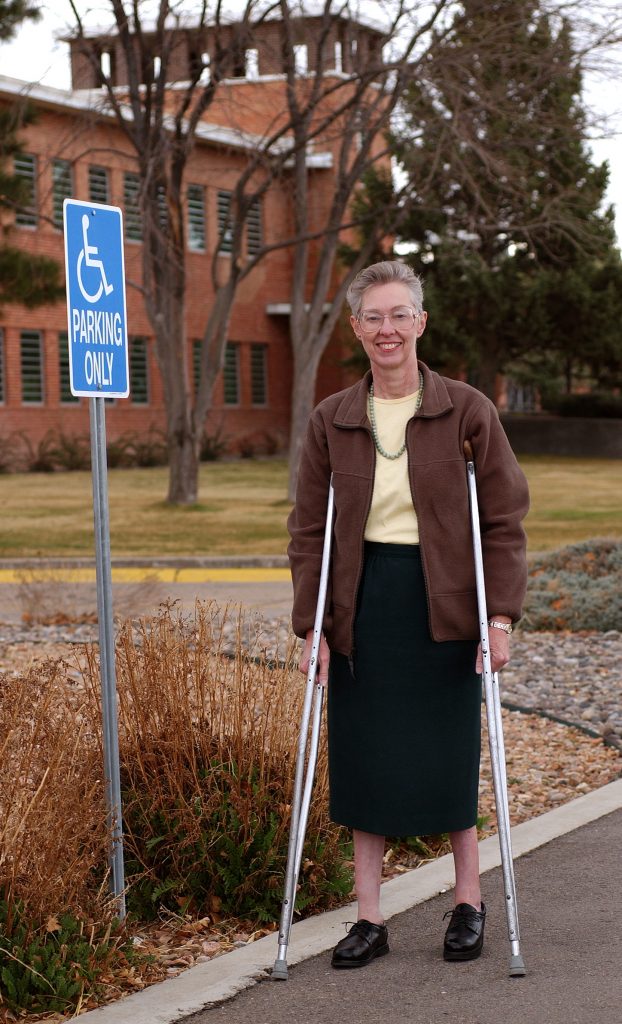
ALBUQUERQUE, N.M. — Sandia National Laboratories risk analyst Regina Hunter was recently named “Employee of the Year” by CAREERS & the disABLED magazine at the Ramada New Yorker hotel in Manhattan for her advocacy efforts on behalf of handicapped people in the workplace.
She was among 10 people from around the country who received the award. Others represented such organizations as NASA, AT&T, US Post Office, Shell Lubricants, Goodrich and IBM.
“As I was getting the award I thought I haven’t done anything to deserve this,” says Hunter, who uses crutches to get around. “The others had done so much more than I did. I was accused of humility at the ceremony, which amuses all my friends.”
Hunter, a founding member of Sandia’s Disability Awareness Committee (DAC), campaigned to get more handicapped parking spaces at the Labs. For many years, handicapped people at Sandia had to park in slots signed “medical” parking, and they were most frequently filled by cars owned by people with medical problems who were not handicapped — or by people with no physical problem at all. She, together with the DAC, worked with Sandia’s Medical department to have specific parking slots marked handicap parking. Now, anyone who does not have a handicap placard who parks in those slots can get a parking ticket and a $100 fine.
She helped coordinate several Sandia Disabilities Awareness Days that made it possible for able-bodied people to discover what it’s like to be disabled. Currently she is developing a plan for recruiting accomplished disabled job candidates and has begun to evaluate who’s internally responsible for funding the accommodations a disabled employee might need. At her own building she worked with Sandia’s Facilities department to improve a steep entrance/exit ramp that was difficult to maneuver.
Hunter has also participated in the Sandia mentoring program and has been active in mentoring new employees and student interns.
In 1952, at the age of four-and-a-half, Hunter contracted polio, part of the last big group in the country to get the crippling disease. She was living in northern California, and the one remaining iron lung in the state was reserved for her. But she didn’t need it.
At first she was paralyzed from the neck down and doctors told her parents that she would never walk again, but she did. Then they told her she would always have to wear leg braces, and she didn’t. It took 13 orthopedic surgeries for her to walk with crutches.
She credits some of her incredible recovery to well-wishers around the world. Hunter says she got polio during National Pet Week — the same week her two little kittens, Fluffy and Seven-Toed Pete, were stolen. She happened to live next door to a reporter for a local newspaper who wrote a story about it.
“Who could resist the little crippled girl whose kittens were stolen?” Hunter says. “The story spread throughout the country and world.”
Two months after she was stricken with polio, she was named Polio Princess of Humboldt County (Calif.) where she lived. American troops in West Germany heard about her and named her their Polio Princess for their March of Dimes Drive. She became a March of Dimes poster child. She got many cards wishing her well from people she didn’t know. She also received a commendation from California’s secretary of state.
Hunter spent most of her life between the ages of 6 to 16 in a Shriner’s Hospital where she had the operations and follow-up physical therapy. The hospital had an accredited grade school and high school that allowed her to learn at her own pace. Between operations she attended public schools in Oregon, where her family lived. Because of the nature of her father’s job, her family moved around a lot, and she attended 18 different public schools by the time she graduated from high school. “I never had any trouble, though, and was always caught up.”
Her passion was science, and after high school she attended the University of Oregon for her BA and the University of Illinois for her PhD, majoring in geology.
Hunter joined Sandia 23 years ago doing performance assessments on the Yucca Mountain project. She has since done similar assessments for WIPP and other programs. Hunter developed the first risk-based approach to building management (called RAMPART for Risk Assessment Method — Property Analysis and Ranking Tool), which assesses the risks of terrorism, natural disasters and crime to buildings.
She says she enjoys her job and her life and adds that her “career goal is to have fun.”
About disabilities in the workplace, she says they are “just a cost of doing business.”
“Disabled people get the job done as well as anyone else,” she says.
Sandia technical contact: Regina Hunter, rlhunte@sandia.gov, (505) 844-5837


